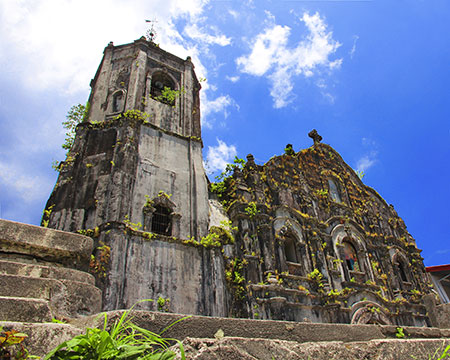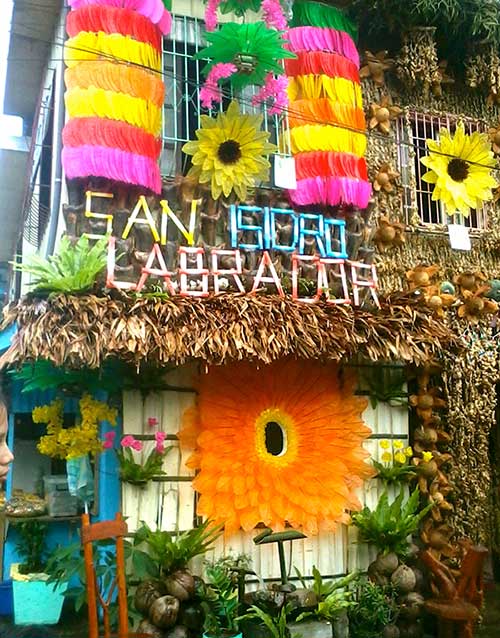
This paper looks into the evolution of the San Isidro Fiesta/Pahiyas Festival in Lucban, Quezon Province, its transformation from a local religious celebration to a popular tourist attraction. The occasion has been held in May since the early Spanish period as thanksgiving (pahiyas in local terms) for a bountiful harvest to San Isidro Labrador (the Catholic Church’s patron saint of farmers), although its origin dates back to a pre-colonial thanksgiving ritual. After a massive national tourism development program in the 1970s, the local celebration was transformed from a small town festivity (fiesta) into a much-publicized event in the country’s tourism calendar (festival), attracting around half a million people during its week-long celebration.
The Governance of Culture
With the state’s intervention in 1973, the administration of the festival was transferred from the local Catholic Parish to the municipal government. The role of the local Church has since been limited to the celebration of the Catholic mass, determining the route of the procession during the feastday, and in organizing the novena (prayers) in the days before the festival. Under government control, the celebration of the Pahiyas Festival has undergone a process of “juridification.” Juridification is the process of political control over the community through bureaucratic and legal methods (Habermas 1987). The transfer of control over the festival from the church to the municipal government has altered the manner in which personnel and resources are organized to complete the various tasks necessary to have a successful celebration. Unlike a typical fiesta where the organization of the celebration falls largely into the hands of informal committees primarily composed of prominent local citizens and the local priest, the Pahiyas Festival is organized by the Execom (Executive Committee), which oversees ten sub-committees assigned to specific functions. Although the Parish Priest and some local residents are still involved in organizing the festival, most of the people in the ten committees are municipal employees. Hence, most of the preparations and the actual management of the various activities are done by paid workers rather than by volunteers who participate in cooperative work, a practice popular during the pre-tourism period. In a typical fiesta in the Philippines, a hermano or hermana mayor (major sponsor) is often chosen among the local elite to pay for particular aspects of the celebration, such as the novena, band, street decorations, or food for important guests. In the Pahiyas Festival, the municipyo (municipal government) now stands as the hermano mayor, taking charge of most aspects of the event. Like a real hermano mayor, the municipyo hires a caterer and sets a dining area in the municipal hall to feed various guests including the Secretary of the Department Of Tourism, national and local politicians, and members of the national and local media, among many others.
Another aspect of the juridification process is the use of legal methods to control the celebration of the Pahiyas Festival. At the beginning of each year, the first memorandum passed by the municipal council directs the establishment of the Execom to prepare for the annual event. The use of the memorandum to organize the Execom marks the shift to the use of enacted policies and regulations instead of simply relying on traditional norms and practices. Almost all aspects of the festival are now directed by policies and regulations either formally enacted by the Municipal Council or formulated by certain committees.

Furthermore, another important change in the Pahiyas Festival is the increasing “rationalization” in the preparation and celebration of the event. Traditional knowledge is often eclipsed by the rationalities offered by “experts” and professionals, as can be seen with the appointment of a consultant to help the Execom. Likewise, some households consult artists and designers to help them conceptualize their decorations and come up with prize-winning displays. Another innovation that was set to rationalize that festival was the hiring of an event management company to handle marketing and corporate communications. In the past, the Execom managed the sponsorship program of the festival. However, they have always had problems connecting with potential sponsors, formulating the sponsorship packages, and in controlling the activities of the sponsors during the festival. Hence, with a professional company handling this side of things, the Execom members believe that it will rationalize the process and make it more efficient.
From Sacred to Secular
In 1973, the name of the San Isidro Fiesta was changed to Pahiyas Festival, marking the shift of the emphasis from a religious ritual to a secular tourism spectacle. Along with the emphasis on tourism, more attention was given to aesthetic considerations such as the form, design, and overall attractiveness of the displays (Punongbayan 1992). Aside from the transformation from a simple thanksgiving to an elaborate festival, Punongbayan notes another significant transformation in the festival. She says (1992: 45):
…(T)he presentation of the pahiyas as a “folk art” – if people were to be invited to see the pahiyas, it must be advertised as an artistic expression of a people’s culture. This has obscured the fact that the pahiyas had been practiced primarily as a ritual, and that the emphasis on its aesthetic feature is a very recent development which must be understood as part of a larger and more complex phenomenon honoring San Isidro Labrador.
The secularization of the ritual showed the increasing influence of civic and tourist-related activites over religious and traditional practices. In the year after the San Isidro Fiesta was transformed into the Pahiyas Festival, the municipal government initiated the awarding of prizes to the most beautiful decorations. Prizes were given to motivate residents to make their decorations more attractive, adding to the aesthetic value of the entire event. Initially, the prizes given were home appliances, farm implements, and water buffalos. However, these were eventually replaced by cash prizes that have steadily increased over the years. In 2007, top prizes ranged from 30,000 to 70,000 pesos while consolation prizes of 10,000 pesos each were given to several entries.

Moreover, the growth of the Pahiyas Festival as one of the major tourist attractions in the country has provided a big source of revenue for the municipality. The event has also served as a venue where residents promote their products to visitors. The municipal government, the Catholic Church, and private individuals rent out commercial spaces where businesses can set up stalls and sell their products. Fastfood chains and multinational companies compete with local small-scale entrepreneurs to exploit the presence of many potential customers. Companies also contribute large amounts of money to sponsor the various activities during the festival. In 2007, Globe Telecom Inc., the country’s biggest mobile telephone company, got the highest sponsorship package by shelling out 800,000 pesos (around US$ 20,000). Although strongly discouraged by the organizers, some residents are paid by companies to use advertising banners and leaflets in decorating their houses. These advertising materials are found everywhere: buntings strung over the streets, floats paraded along the procession route, costumes worn by the traditional higantes (giant mascots), and posters of various sizes placed on just about any available surface in town.
As a result, commercial sponsorship became a a source of conflict between the municipal government and the Catholic Church, as well as other interest groups. As part of the sponsorship package, it was agreed that Globe Telecom will have exclusive exposure during the festival, which means that any of its competitors will not be allowed to have their own advertising campaigns. However, the Catholic Church allowed a competitor company to rent space and set up a promotion booth inside its premises. The Execom expressed their protest to the parish priest. The parish priest explained that it was the Parish Pastoral Council (PPC) that decided to accept the competitor so the parish can raise some funds for its various projects. Since some PPC members are influential, the Execom was not able to execute any actions other than the protest. In another case, a conflict between the Execom and the local college also emerged after the latter scheduled a musical concert inside its premises sponsored by Globe Telecom’s competitor. Since a summons ordering the cancellation of the concert failed to persuade the concert organizers, the Execom filed a complaint in the municipal court to issue a Restraining Order to stop the holding of the concert.

Revenue Over Ritual
As profit-oriented motives took hold, some people criticized the use of large amounts of cash for prizes and even the practice of soliciting money from sponsors, arguing that these have made the celebration over-commercialized. For instance, the pahiyas or the food, fruits, and vegetables displayed outside the houses that were once given out to visitors after the procession are now being sold. Likewise, more and more people are now having the pahiyas to merely compete in the contest that is being organized by the municipal government instead of decorating the façade of their houses as thanksgiving to San Isidro. The contests are primarily held to encourage the residents to make their decorations more colorful and artistic, thus more appealing to tourists. Many residents are saying that the Pahiyas Festival is losing its religious meaning because of greater attention given to the different secular activities. What were once religious displays that have become part of local tradition are now cultural products that meet the needs of commercialism and tourism.
Lou Antolihao
Former JSPS Postdoctoral Fellow, Center for Southeast Asian Studies
Kyoto University
Kyoto Review of Southeast Asia (issue 15), Young Academics Voice, April 2014
References
Habermas, Jurgen. 1987. The Theory of Communicative Action, Vol. 2. Life-World and
System: A Critique of Functionalist Reason. Translated by T. McCarthy. Boston: Beacon Press.
Punongbayan, Pearl T. 1992. The Pahiyas in Lucban, Quezon: A Preliminary Study. Art Studies Journal, vol. 1 (no. 1), 39-51.

